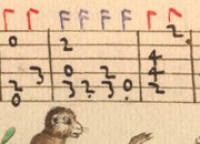Musicological research topics
Sixteenth-Century Lute and Vocal Music
Although its origins are in the previous century, lute tablature notation became extremely important in the early years of the sixteenth century, and its rise is closely linked to the rise of printed music as a whole. The release of digitised scans of over 300 books of early modern printed music by the Early Music Online project (Royal Holloway and the British Library), when combined with the material in the Electronic Corpus of Lute Music, has made digital investigation of this period possible possible, with the aim of strengthening the evidential bases for our musicological understanding of the music of the period. Of particular interest is the interaction between instrumental and vocal music from a time when approximately half of the lute and keyboard music that survives consists of arrangements of originally sung source material.
Main researchers: Tim Crawford, David Lewis, Richard Lewis, Kevin Page, Christophe Rhodes, Frans Wiering.
Selected key papers:
Tim Crawford & David Lewis (May 2017). ‘Early modern cover song detection: finding concordances in mixed-notation corpora of early music’. In Music Encoding Conference, Tours.
David Lewis, Tim Crawford, and Daniel Müllensiefen (August 2016). ‘Instrumental Idiom in the 16th Century: Embellishment Patterns in Arrangements of Vocal Music’. In Proceedings of the International Society for Music Information Retrieval Conference (ISMIR 2016). New York, NY. [pdf]
Richard J. Lewis, Tim Crawford, and David Lewis (November 2015). ‘Exploring information retrieval, semantic technologies and workflows for music scholarship: the Transforming Musicology project’. Early Music 43.4, pp. 635-647. [full text |DOI:10.1093/em/cav073]
David Lewis, Richard Lewis, and Tim Crawford (May 2015). ‘MEI for lute music’. In Proceedings of the Music Encoding Conference (MEC 2015). Florence, Italy.
Tim Crawford, Ben Fields, David Lewis, and Kevin Page (September 2014). ‘Explorations in Linked Data practice for early music corpora’. In Proceedings of the Joint Conference on Digital Libraries (JCDL 2014). London. [eprint |ieee |DOI: 10.1109/JCDL.2014.6970184]
Christophe Rhodes, Tim Crawford, and Mark d'Inverno (July 2014). ‘Duplicate detection in facsimile scans of early printed music’. In Proceedings of the European Conference on Data Analysis. Bremen. [eprint |slides]

Lute tablature (and a monkey) from the Capirola MS
http://ricercar.cesr.univ-tours.fr/3-programmes/EMN/luth/sources/Capirol...
Wagner and the Leitmotive
Wagner's use of musical material that recurrs throughout an opera to characterise a person or an idea is complex, and his approach to these motives evolves through his life. The systematic identification and naming of these did not, however, form part of the plan for the reception of his works: his admirers named and explained them, dubbed them leitmotives, and published guides to the their occurrences in his operas.
Transforming Musicology's investigation of the Leitmotive followed several parallel approaches. While Laurence Dreyfus looked to the music of the operas for evidence of Wagner's own dramatic strategies, Carolin Rindfleisch approached the guides themselves, seeing what they tell us about the reception of Wagner's operas. In addition to these more traditional and historically-oriented musicological undertakings, Daniel Müllensiefen took a psychological approach, considering how the music is perceived now. Through memory experiments and taking live biometric measurements during a complete performance of the Ring cycle, he investigated physical responses to Wagner’s compositional strategies.
Main researchers: Laurence Dreyfus, Carolin Rindfleisch, Daniel Müllensiefen, Tim Crawford, Christophe Rhodes, Kevin Page, Richard Lewis, Terhi Nurmikko-Fuller.
Selected key papers:
Kevin Page and Carolin Rindfleisch (March 2017), ‘Linking Leitmotifs: A Digital Study of Leitmotif Interpretations through Ontologically Contextualised Notation’, In International Musicological Society, Tokyo.
David Baker, and Daniel Müllensiefen (July 2016). ‘Hearing Wagner: Physiological Responses to Richard Wagner's Der Ring des Nibelungen’. In Proceedings of 14th International Conference for Music Cognition and Perception. San Francisco, CA. [poster]
Carolin Rindfleisch (April 2016). ‘Emulating Performance? Richard Wagner’s Descriptions of his Leitmotifs’. In Inaugural conference of the Northern Opera Research Network. Huddersfield, UK.
Carolin Rindfleisch (January 2016). ‘'The eternal question to fate, surging up from the depth': Richard Wagner’s Descriptions of his Leitmotives in Changing Contexts of Communication’. In RMA Students' Conference 2016. Bangor, UK.
Kevin Page, Terhi Nurmikko-Fuller, Carolin Rindfleisch, Richard Lewis, Laurence Dreyfus, and David De Roure (October 2015). ‘A toolkit for live annotation of opera performance: Experiences capturing Wagner's Ring Cycle’. In Proceedings of the International Society for Music Information Retrieval Conference (ISMIR 2015). Málaga, Spain. [pdf]
Daniel Müllensiefen, David Baker, Christophe Rhodes, Tim Crawford, and Laurence Dreyfus (July 2014). ‘Recognition of leitmotives in Richard Wagner's music: chroma distance and listener expertise’. In Proceedings of the European Conference on Data Analysis. Bremen. [eprint |slides]

Musicology of the Social Media
As music becomes increasingly – almost exclusively – consumed and discussed through the Internet, it seems that musicology should adapt accordingly, developing new methodologies capable of taking into consideration massive amounts of evidence that comes in entirely new forms. Using techniques from MIR, network analysis, musicology and sociology, Transforming Musicology began to explore the tools and approaches that might help us develop ways by which online communities and their patterns of consumption and reception can be studied.
Social networks operate in scholarship as well, and the techniques use here were also applied, in a preliminary way, to RILM bibliographic data.
Main researchers: Ben Fields, Justin Gagen, Christophe Rhodes, Kevin Page, David Lewis
Selected key publications:
David Lewis, Yun Fan, Glenn Henshaw & Kevin Page, ‘Musicology of Digital Libraries: structures in RILM’, In Proceedings of the Fourth International Workshop on Digital Libraries for Musicology (DLfM 2017). Shanghai [acm |DOI 10.1145/3144749.3144762]
Ben Fields, and Christophe Rhodes (August 2016). ‘Listen To Me – Don't Listen To Me: What Communities of Critics Tell Us About Music’. In Proceedings of the International Society for Music Information Retrieval Conference (ISMIR 2016). New York, NY. [pdf]
Justin Gagen (May 2015). ‘Auditing The Echonest – Investigations to gauge output accuracy’. In Auditing Algorithms From the Outside: Methods and Implications at AAAI Conference on Web and Social Media (ICWSM). Oxford, UK. [abstract]



